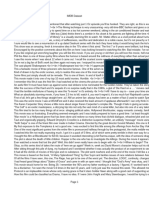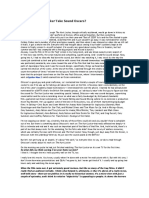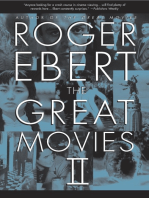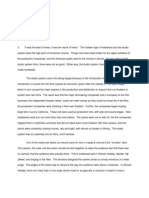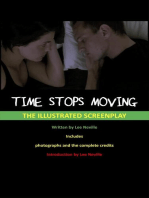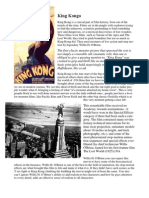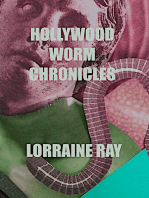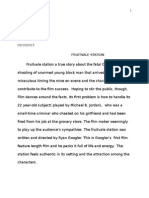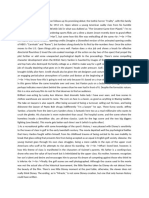Film1023 Final Essay
Film1023 Final Essay
Uploaded by
api-237702734Copyright:
Available Formats
Film1023 Final Essay
Film1023 Final Essay
Uploaded by
api-237702734Original Title
Copyright
Available Formats
Share this document
Did you find this document useful?
Is this content inappropriate?
Copyright:
Available Formats
Film1023 Final Essay
Film1023 Final Essay
Uploaded by
api-237702734Copyright:
Available Formats
Romboy1 Richard Romboy Alexander Langshall Film 1023 1 October 2013 My Understanding of Film I watch a lot of movies, but
I dont know that Im an obsessive movie watcher and I only have a rough vocabulary of cinematic terms. Listening to the guys in the lobby of the Tower or Broadway truly makes me want to retch and I know some of them socially; they talk like that even when they do not want to be overheard. This attitude may come as a surprise because I see almost every film, indie or blockbuster that comes to Salt Lake. So yes, I watch a lot of movies but I watch them like I read a Patterson or Child or Grisham novel, purely for entertainment not to be thought of or analyzed but solely for enjoyment. It is no great shock that I had some initial trepidation that taking a film class (and paying attention) would turn me into one of those golf hatted, scruffy bearded, skinny jeans wearing, and courier bike riding wackos. Besides I really like speaking English. However, my understanding of film did increase as did my appreciation with a greater knowledge of how movies are made in terms of technique and methods. There is no doubt that I did not like and still do not like some of the films shown during this course but I certainly understand them more and can appreciate them (if not for their content) at least in how they were made. The first film that comes to mind in the appreciate but do not like category is Akira Kurosawaa Ran. I would much rather have seen King Lear onstage in English, in fact I have a couple of times. But I digress, Kurosawas placement of characters, and the detail of his sets are
Romboy2 masterful. He uses natural and man-made sets to set the tone of his scenes, chock-a-bloc with symbolism and uses it to express the emotion of the characters. This mise-en-scene, a term I had never heard before, paints the movie for the viewer. Even without actors or lines even music one could watch this movie and feel the plot, the conflict, as an aura so to speak. My favorite scene is in the castle when Lord Hidetora is under attack. As he stumbles around the burning tower dragging his sword, his whole life seemingly under attack, he goes mad. Walking out the front of the flaming castle keep there is such strong imagery of all that he built by force destroyed by the same and at the same time he is framed by the building itself, very house-like, symbolizing the fall of his own house. Citizen Kane is such a film class clich that I couldnt help roll my eyes upon seeing it in the syllabus. I saw it as a teenager at my Dads suggestion after a trip to Hearst Castle. I was fascinated by San Simeon and the extravagance of the Robber Baron age. I didnt see the movie for much more than a dark parody of Hearsts life and legacy. Why all the talk about Orson Welles genius and best movie ever? Certainly I maintain my original position on it being a shot at the ultra-wealthy capitalists of that era but the innovation in movie making supersedes the story by far. Being somewhat familiar with the story already I was able to watch the film with an open mind so to speak. I paid scant attention to the dialogue or character as compared with how the movie was constructed and I noticed a number of exciting devices that I had not ever experienced in a movie that old. Welles loves his scenes. Right from the credits he starts to play with the medium. As the camera takes us closer to Xanadu and the lonely lit window at the top we are suddenly inside that room with the use of a form cut so slick it is as if we have sliced through the wall. Citizen Kane uses time masterfully, as a rapid fan of history and its accurate portrayal I was very pleased to see Welles attention to detail in several respects. He makes great
Romboy3 use of architecture in the film and the buildings he films are accurate to the timeline of the story. He uses no buildings in the 1890s that arent accurate but as the film progresses he uses newer and newer buildings. A good example is the first newspaper building he buys which is late 1800s sandstone and which plays a role throughout the film but as Kane grows older newer buildings are incorporated in street scenes. This brings me to Kanes age himself. One of my classmates even commented that he wasnt sure it was the same actor throughout the film. Thats high praise from a modern audience. Kane advancing age is done subtly and in shifts, as his suits change style his hair changes as does his face with what I consider great make-up work far better in my opinion than the much later movie Ran from 1984. Make-up and hair play a role in the character development as well for after Kanes political defeat, and his seemingly all-powerful money and influence begin to wane there is a sudden shift in his hairline and the wrinkles in his face. Kane has suddenly become old and its a powerful piece of filmmaking. Even though this is no Avant garde breakthrough in filmmaking, I had always assumed that when two things on screen were simultaneously in focus it had to be multiple cameras in use and some nifty editing. I didnt realize that the visual effect could actually be on the film itself as in the pill bottle on Kanes wifes side table. The art of matte painting in film is an amazing and I think little appreciated position outside the industry. Citizen Kane is one of the most highly regarded black and white movies of our time and a great example of evolution in film from the old silent films accompanied by pianos in smoky theatres but what could a modern filmmaker with all the latest technology and great actors achieve if he wanted to make an old movie? Enter The Artist a French film that took the Americas and the world by storm. The Artist is a great example of how understanding a film can dampen ones enthusiasm for it. I loved the movie, one of the only movies in recent times I have
Romboy4 seen in the theatre twice. I was so happy that it beat out all the American Blockbusters to win the Oscar(s), I mean I was saying way to go, hurrah, and death to the film establishment! I did two of my assignments on this film and I think I got more perspective on the industry and technical information in my own research than Id bargained for. I suppose some nave part of me thought it a movie made in the old way, homage to silent film with a talented cast and visionary director. Some of this is true, namely that it does pay tribute to silent film but thats about it. Hazanavicius made a modern film look old. Visually he did this by using an unusual aspect ratio and by filming with slightly fewer frames per second. Using an aspect ratio of 4:3 he deviated from the widescreen format currently used in almost all movies. This aspect ratio created a boxy, smaller screen indicative of silent movies. I say indicative because this format is more akin to older styles of television rather than a truly older movie. Secondly he changed the frames per second filming to speed up the actors movements. Filming the movie in 22 fps we get more of the feel of an old film but it is a far cry from the 16 and 18 fps at which true silent films ran. This is really not that far from 24 fps, the industry standard for many years. Other areas in the making of The Artist are deceptive and at the same time ingenious. Hazanavicius assembled a very talented cast of stage actors capable of any role but he didnt throw them to the wolves so to speak. On set he played music from old films and ran antique cameras to create the ambience of old movies. The other main difference lies in the leads themselves. In olden times an actor or actress was hired because they could sing, dance and act where nowadays a desired actor has the time and wherewithal to study into their part, take DuJardin and Bejo for example who studied tap dancing for six months to prepare for their role. The last and final shred of my innocence fell away when I understood the film industries role in The Artists success. Hazanavicius like any other filmmaker wanted to make money and
Romboy5 garner fame. Almost unknown outside of France as were his two principals he got the film into Cannes in hopes of picking up a distributor. For most independent films this is simply de rigeur. Winning at Cannes I believe guaranteed the interest of U.S. distributors and in fact the movie was taken on by The Weinstein Company. Known for savvy acumen when it comes to picking winners, Weinsteins involvement guaranteed a world stage to present this film on. With the box office success in the U.S. The Artist became a different animal than it was originally, it changed into a blockbuster that was just different enough to justify Oscar votes. One of the most fascinating parts of filmmaking to me is the Kuleshov Cut. Intuitively I already agreed with its premise. I have watched so many movies, have been emotionally moved by many and yet some of its most basic techniques were alien to me. I was like many ticket purchasers just along for the ride. Now that I look for it I can see it in many movies, but the one I want to bring to attention is Kuleshov and Clint Eastwood. There is little debate that Clint Eastwoods early career could be described as great acting or even good acting. Even though he has certainly matured into a great director every time I see him on screen I wonder where his revolver and cigar are. Has his acting improved? I argue that it has not. Watching Million Dollar Baby is one long Kuleshov Cut after another. Two distinct scenes come to mind both opposite Maggie played by Hilary Swank, who I think can act her a** off. The first scene occurs in the gym as Maggie is begging Eastwoods character to train her. The gym is dark and the shot is at eye level lots of shadow in their faces and the light perfectly illuminates their eyes. As the camera cuts from Eastwood to Swank, neither Clints expression nor voice change (does it in any of his scenes?) but Maggie pleads and agrees and I could swear you can see the resistance fade, the brusque demeanor change from dis-interest to a grudging acceptance. The second scene is Maggies deathbed, cutting from Swank proud and desiring noble death, to her tearful release
Romboy6 from the pain. Yet again Clints in stoic expression do we really see compassion, and love or is it what we want to feel based on Maggies condition? In conclusion this class has definitely expanded my understanding of film. I have been able to watch films I have seen before and understand the way they were made thus increasing my appreciation if not my opinion. And I have had my emotional attachment to a film I thought I really liked downgraded as I delved into the film itself, not just the story. I have also come to appreciate the medium itself more. Movies are nothing more than a two-dimensional image on a screen that through trickery or technology show us still pictures our minds believe are moving spatially in front of us, yet it is an art form which evokes the suspense, empathy and excitement of its audience. Film has always been on the front lines of technology ever pushing into new ways to show a story, sometimes creating advances for its own needs that spill over into the real world. It begs the question of where will they go next? I remember how realistic George Lucas Star Wars was when it came out and how far Avatar and The Life of Pi have progressed past that. Im not sure even the filmmakers know. I am in no danger of shopping at vintage clothing stores and have no plans to trade my car for a bicycle but I have to admit Ive got more in common with film-geeks than other people do, we cant wait to see the next release.
You might also like
- Good Clinical PracticeDocument21 pagesGood Clinical PracticeanisaishakNo ratings yet
- Jim Rohn - 12 PillarsDocument17 pagesJim Rohn - 12 PillarsMarco199897% (39)
- If You Like Quentin Tarantino...: Here Are Over 200 Films, TV Shows and Other Oddities That You Will LoveFrom EverandIf You Like Quentin Tarantino...: Here Are Over 200 Films, TV Shows and Other Oddities That You Will LoveNo ratings yet
- Citizen Kane Film AnalysisDocument6 pagesCitizen Kane Film AnalysisJune Zhang Yuruo100% (1)
- IMDB Dataset - CSV 0Document2,104 pagesIMDB Dataset - CSV 0sbihi marwanNo ratings yet
- Film Chronicle: by Alan LovellDocument3 pagesFilm Chronicle: by Alan LovelldomlashNo ratings yet
- Horror As A GenreDocument7 pagesHorror As A Genreapi-636571933No ratings yet
- Film Philosophy Reflexive Journal Word DocumentDocument11 pagesFilm Philosophy Reflexive Journal Word DocumentMaría Victoria LondoñoNo ratings yet
- Boards ReelDocument3 pagesBoards ReeljoewarboNo ratings yet
- Describing Movies DefinitionsDocument10 pagesDescribing Movies DefinitionsЭльмира МусаеваNo ratings yet
- The TraditionalistDocument10 pagesThe TraditionalistMatt JenkinsNo ratings yet
- Although An Utterly Engrossing and Fascinating StoryDocument2 pagesAlthough An Utterly Engrossing and Fascinating Storytechward.siNo ratings yet
- Time After Time Movie ReviewDocument2 pagesTime After Time Movie ReviewOshram KinoNo ratings yet
- Directing ResearchDocument6 pagesDirecting Researchapi-479739265No ratings yet
- 2 Hurt LockerDocument3 pages2 Hurt LockerCamilo MorenoNo ratings yet
- The Best Film You've Never Seen: 35 Directors Champion the Forgotten or Critically Savaged Movies They LoveFrom EverandThe Best Film You've Never Seen: 35 Directors Champion the Forgotten or Critically Savaged Movies They LoveRating: 5 out of 5 stars5/5 (1)
- Ex. 1 Match These Words With Their Definitions BelowDocument14 pagesEx. 1 Match These Words With Their Definitions BelowKonstantin KachanovskyNo ratings yet
- Unit 12Document6 pagesUnit 12api-571130209No ratings yet
- Hugo As Similar Examples of Which Michel Hazanavicius's The Artist Could RestDocument3 pagesHugo As Similar Examples of Which Michel Hazanavicius's The Artist Could RestJason ShanerNo ratings yet
- Essay On CinemaDocument6 pagesEssay On CinemaHanna SandlerNo ratings yet
- The Film Buff's Bucket List: The 50 Movies of the 2000s to See Before You DieFrom EverandThe Film Buff's Bucket List: The 50 Movies of the 2000s to See Before You DieRating: 3 out of 5 stars3/5 (2)
- Film Analysis Essay GuidelinesDocument4 pagesFilm Analysis Essay Guidelinessrahimi@verizon.netNo ratings yet
- IMDB ReviewDocument3,245 pagesIMDB ReviewVilla Sekar citaNo ratings yet
- The Church of Baseball: The Making of Bull Durham: Home Runs, Bad Calls, Crazy Fights, Big Swings, and a HitFrom EverandThe Church of Baseball: The Making of Bull Durham: Home Runs, Bad Calls, Crazy Fights, Big Swings, and a HitNo ratings yet
- Ms Doc 2Document11 pagesMs Doc 2api-380472829No ratings yet
- Assignment 1 Pulp FictionDocument5 pagesAssignment 1 Pulp Fictionapi-540332171No ratings yet
- FILM ANALYSIS No. 7 - OcalenaDocument2 pagesFILM ANALYSIS No. 7 - OcalenaHannah OcaleñaNo ratings yet
- Cinematography EssayDocument4 pagesCinematography Essayapi-569780884No ratings yet
- BOXedMAN: I'm Going To Make A Movie - Why Are You Laughing?From EverandBOXedMAN: I'm Going To Make A Movie - Why Are You Laughing?No ratings yet
- Flickering Treasures: Rediscovering Baltimore's Forgotten Movie TheatersFrom EverandFlickering Treasures: Rediscovering Baltimore's Forgotten Movie TheatersNo ratings yet
- Bobbi Jo BurrowsDocument7 pagesBobbi Jo BurrowsBobbiNo ratings yet
- 50 Marker, Time and SpaceDocument4 pages50 Marker, Time and Spacetomlamb03No ratings yet
- Get the Picture?: The Movie Lover's Guide to Watching FilmsFrom EverandGet the Picture?: The Movie Lover's Guide to Watching FilmsRating: 3 out of 5 stars3/5 (6)
- FFM113: Fundamentals of Theatre and Film Production Management Lecturer: Raja Nor Aminah Binti Raja AyobDocument10 pagesFFM113: Fundamentals of Theatre and Film Production Management Lecturer: Raja Nor Aminah Binti Raja AyobAKMAL DANISH ALIPENo ratings yet
- The Film That Changed My Life: 30 Directors on Their Epiphanies in the DarkFrom EverandThe Film That Changed My Life: 30 Directors on Their Epiphanies in the DarkNo ratings yet
- Time Stops Moving - The Illustrated Screenplay: The Lee Neville Entertainment Screenplay Series, #2From EverandTime Stops Moving - The Illustrated Screenplay: The Lee Neville Entertainment Screenplay Series, #2No ratings yet
- Days of Being Wild: Wong Kar-Wai'sDocument5 pagesDays of Being Wild: Wong Kar-Wai'sHiperativaNo ratings yet
- King KongDocument3 pagesKing KongDaniel HarringtonNo ratings yet
- Fruitvale StationDocument4 pagesFruitvale Stationapi-284386588No ratings yet
- ModelDocument38 pagesModeljshajyhNo ratings yet
- David Fincher 1 (Autosaved)Document10 pagesDavid Fincher 1 (Autosaved)kundaiNo ratings yet
- PlanDocument2 pagesPlanCDouglasByrnesNo ratings yet
- Identity 2003: Like A Hit To The Head From Left FieldDocument20 pagesIdentity 2003: Like A Hit To The Head From Left FieldStefan TecliciNo ratings yet
- Director's Cut - Hirokazu Kore-Eda ('Like Father, Like Son') - MTVDocument8 pagesDirector's Cut - Hirokazu Kore-Eda ('Like Father, Like Son') - MTVMax PowerNo ratings yet
- Incredibles 2 PCDocument13 pagesIncredibles 2 PCAlNo ratings yet
- Gutter Auteur The Films of Andy Milligan by Rob CraigForeword by Robert PatrickDocument536 pagesGutter Auteur The Films of Andy Milligan by Rob CraigForeword by Robert PatrickArch HallNo ratings yet
- Potemkin Film CritiqueDocument6 pagesPotemkin Film CritiqueOri SeinNo ratings yet
- "National Treasure2 "By: Jon Turteltaub " There Are A Select FewDocument14 pages"National Treasure2 "By: Jon Turteltaub " There Are A Select Fewjohmer24No ratings yet
- Cinematography ScriptDocument5 pagesCinematography Scriptapi-481638701No ratings yet
- Film Appreciation Prof. Aysha Iqbal Department of Humanities and Social Science Indian Institute of Technology, Madras Lecture - 20 Raging BullDocument9 pagesFilm Appreciation Prof. Aysha Iqbal Department of Humanities and Social Science Indian Institute of Technology, Madras Lecture - 20 Raging BullEnglish DepartmentNo ratings yet
- The Metaphoric Quasi Gonzo Pre FinaleDocument13 pagesThe Metaphoric Quasi Gonzo Pre FinaleTiphani LawNo ratings yet
- FIFAM2015 Josef StaifDocument4 pagesFIFAM2015 Josef StaifJosef ŠtaifNo ratings yet
- Reading the Silver Screen: A Film Lover's Guide to Decoding the Art Form That MovesFrom EverandReading the Silver Screen: A Film Lover's Guide to Decoding the Art Form That MovesRating: 3 out of 5 stars3/5 (3)
- Business Standard - 01 June 2020 PDFDocument15 pagesBusiness Standard - 01 June 2020 PDFSurbhi SabharwalNo ratings yet
- Votar FmsDocument79 pagesVotar Fmssebastian francoNo ratings yet
- Parajumble 75Document51 pagesParajumble 75Rajnish kumarNo ratings yet
- DepreciationDocument11 pagesDepreciationisheikhNo ratings yet
- 6.2 - Paper The 7th ElementDocument15 pages6.2 - Paper The 7th ElementBebincaNo ratings yet
- Gifts of MenDocument3 pagesGifts of MenPaul SavvyNo ratings yet
- EAS Recommended Practices - Agile ContractingDocument79 pagesEAS Recommended Practices - Agile ContractingJustNo ratings yet
- 2020 01 14 Quantum EspressoDocument64 pages2020 01 14 Quantum EspressozhanzoNo ratings yet
- Lab 4 - DMFCDocument11 pagesLab 4 - DMFCNeel NadparaNo ratings yet
- To Kill A Mockingbird - Example of Escape andDocument6 pagesTo Kill A Mockingbird - Example of Escape andCatherine Nicole SamsonNo ratings yet
- Mini Project 2 HyperloopDocument26 pagesMini Project 2 HyperloopSushil SrivastavaNo ratings yet
- Industrial RevolutionDocument24 pagesIndustrial RevolutionHafsah SiddiquaNo ratings yet
- Bluetooth ToolsDocument30 pagesBluetooth ToolsMarco Antonio Martinez AndradeNo ratings yet
- Petroglyphs LeQuellecDocument38 pagesPetroglyphs LeQuellecAdel MeramedNo ratings yet
- Adobe Scan 01 Aug 2023Document1 pageAdobe Scan 01 Aug 2023nbn8785No ratings yet
- MANAGEMENT - MANAGEMENT PRINCIPLES AND APPLICATION 3rd SemDocument2 pagesMANAGEMENT - MANAGEMENT PRINCIPLES AND APPLICATION 3rd SemUzair ShahNo ratings yet
- Q3 - Sci 9 Lesson Plan 4Document16 pagesQ3 - Sci 9 Lesson Plan 4Jo BontilaoNo ratings yet
- Comparison of Quantitatave and Qualitative ResearchDocument6 pagesComparison of Quantitatave and Qualitative Researchkristine collins YambaoNo ratings yet
- Cyprus - Andreas NeocleousDocument10 pagesCyprus - Andreas NeocleousOndrej ProtopapasNo ratings yet
- Daizuki Seer13 32kbtuDocument2 pagesDaizuki Seer13 32kbtuSolucionesenfrio saNo ratings yet
- Designation: D6496/D6496M - 20: Date: To: Tech Contact: Work Item #: Ballot ActionDocument2 pagesDesignation: D6496/D6496M - 20: Date: To: Tech Contact: Work Item #: Ballot ActionEdward Carhuanina LescanoNo ratings yet
- FASTADocument4 pagesFASTADhakshayani GNo ratings yet
- جزوه درس رادارDocument121 pagesجزوه درس رادارbahram bahramiNo ratings yet
- 03 - Science, Technology and Nation-BuildingDocument17 pages03 - Science, Technology and Nation-BuildingeclarexeNo ratings yet
- Abhijit Dhar - CV1Document2 pagesAbhijit Dhar - CV1Abhijit PhoenixNo ratings yet
- Cloud Computing: Saswati MukherjeeDocument141 pagesCloud Computing: Saswati MukherjeeselshiaNo ratings yet
- Monitoring and Diagnostics of PV Plants by A Wireless Self-Powered Sensor For Individual PanelsDocument9 pagesMonitoring and Diagnostics of PV Plants by A Wireless Self-Powered Sensor For Individual PanelsDevil faNo ratings yet
- Pre Cal 1st Semester (Midterm) - ReviewerDocument5 pagesPre Cal 1st Semester (Midterm) - ReviewerFrancine Chalcy CanlasNo ratings yet




